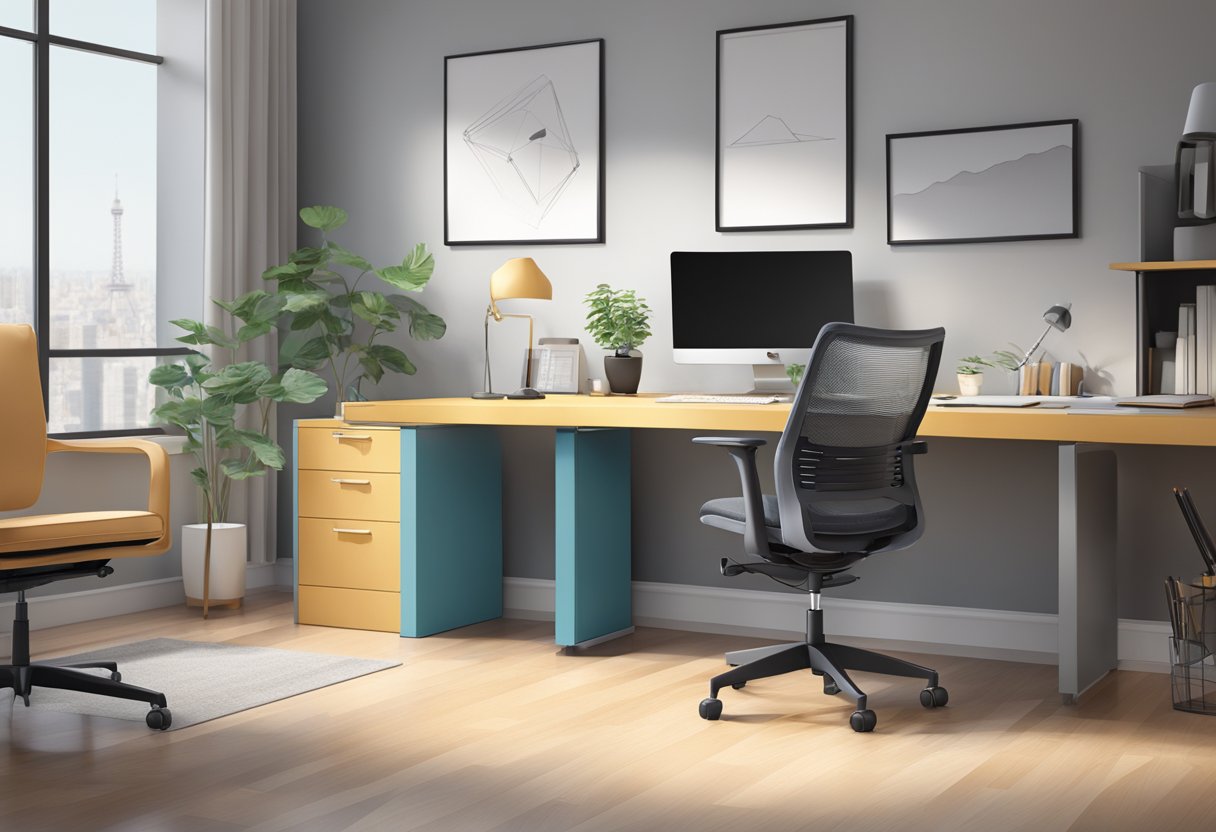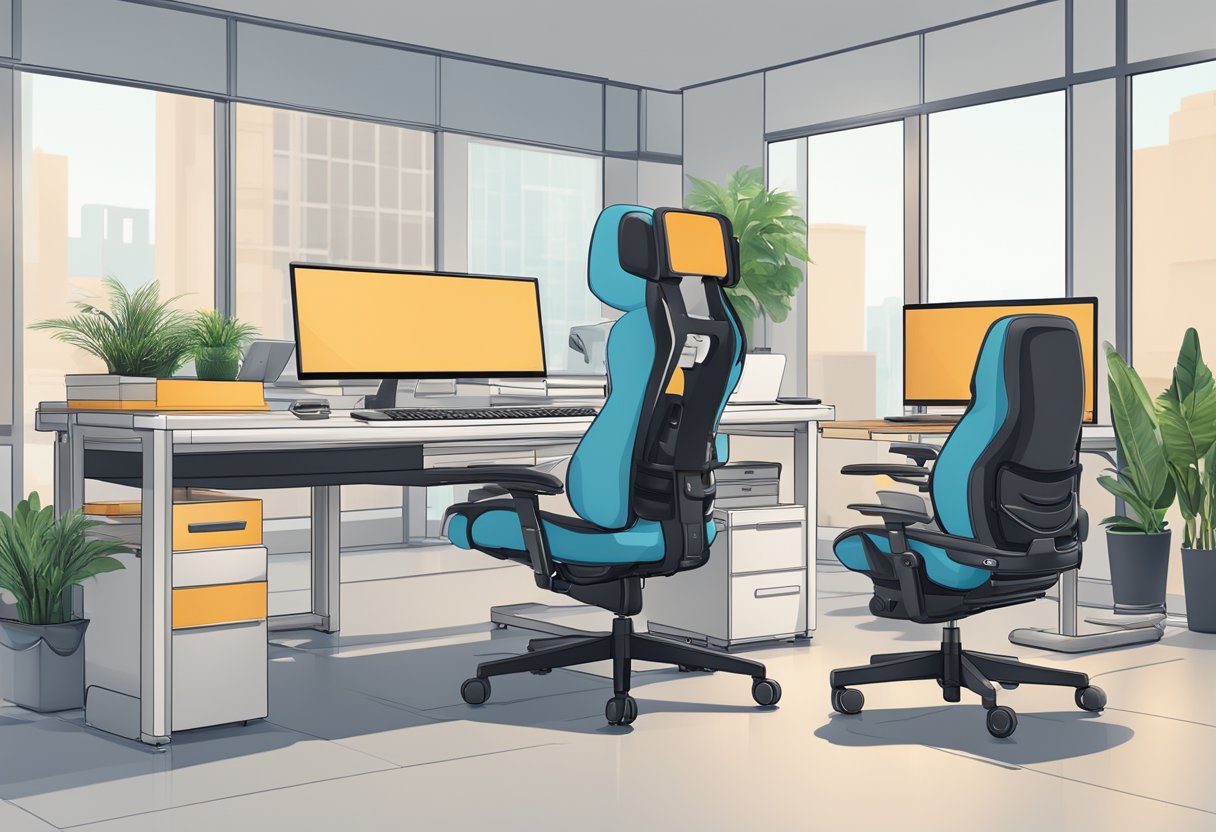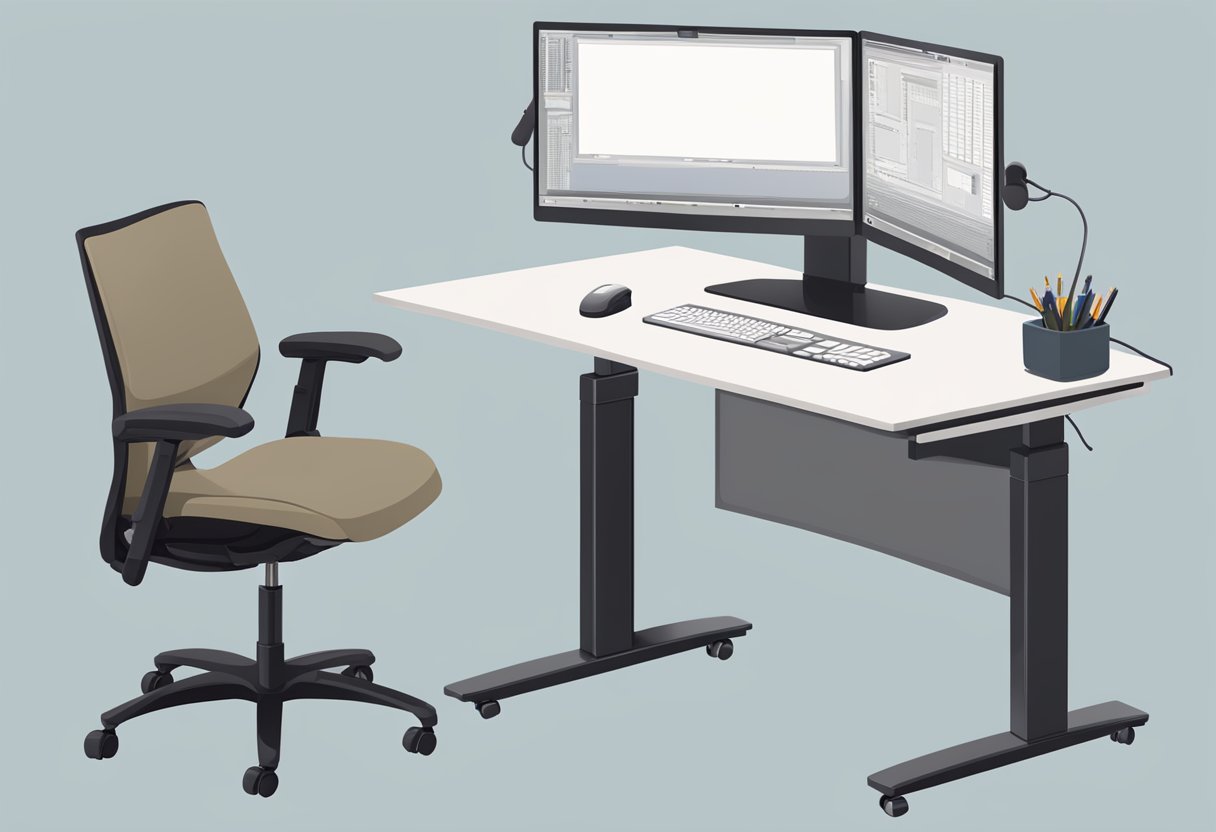- You are here:
- Home »
- Desk Tips »
- Ergonomic Height for Desk: How to Set it Up for Optimal Comfort and Health
Ergonomic Height for Desk: How to Set it Up for Optimal Comfort and Health
As an Amazon Associate I earn from qualifying purchases.
Are you experiencing discomfort or pain while working at your desk? If so, it might be time to consider the ergonomic height of your workstation. Ergonomics is the study of how people interact with their environment, and in the case of office work, it refers to designing a workspace that promotes comfort, health, and productivity. One of the most important aspects of an ergonomic setup is ensuring that your desk is at the correct height for your body.

Understanding Ergonomic Desk Height
The ergonomic height of your desk is determined by the height of your chair and the position of your arms and hands while typing or using a mouse. Ideally, your elbows should be at a 90-degree angle and your wrists should be straight while you work. If your desk is too high or too low, you may experience pain or discomfort in your neck, shoulders, back, or arms. Adjusting your desk height to the correct ergonomic position can alleviate these issues and improve your overall health and productivity.
Achieving Comfort and Health in Your Workspace
Creating an ergonomic workstation involves more than just adjusting your desk height. It also involves choosing the right chair, monitor, keyboard, and mouse, and making sure they are positioned correctly. By taking the time to set up your workspace in an ergonomic manner, you can reduce the risk of injury, improve your posture, and increase your comfort and productivity.
Key Takeaways
- Ergonomics is the study of designing a workspace that promotes comfort, health, and productivity.
- The ergonomic height of your desk is determined by the height of your chair and the position of your arms and hands while typing or using a mouse.
- Creating an ergonomic workstation involves more than just adjusting your desk height; it also involves choosing the right equipment and positioning it correctly.
Understanding Ergonomic Desk Height
https://www.youtube.com/watch?v=Tse6AWnVgpY&embed=true
When it comes to setting up your workspace, one of the most important factors to consider is the height of your desk. Proper ergonomic desk height can help prevent discomfort and injury, whether you’re sitting or standing at your desk.
The standard desk height for a seated position is around 29 inches (74 cm), but this may not be the ideal height for everyone. If your desk is too high or too low, it can cause strain on your neck, shoulders, and back. To find the ideal desk height for you, you should consider your height and the type of work you’ll be doing.
If you’re primarily sitting at your desk, the ideal desk height should allow your feet to rest flat on the floor, with your knees at a 90-degree angle and your elbows at a 90- to 110-degree angle. You may want to consider an adjustable desk or a footrest to help achieve this position.
If you’re primarily standing at your desk, the ideal standing desk height should allow your elbows to rest at a 90-degree angle and your wrists to be in a neutral position. A height-adjustable desk can help you find the perfect standing desk height for your needs.
It’s important to note that your ideal desk height may vary depending on your individual needs and preferences. Consulting a desk height chart or speaking with an ergonomic expert can help you determine the best desk height for you.
Overall, finding the right ergonomic desk height can help improve your comfort and productivity, whether you’re sitting or standing at your desk.
Achieving Comfort and Health in Your Workspace
https://www.youtube.com/watch?v=hKaL-iyDXwQ&embed=true
When it comes to working at a desk, achieving comfort and health should be your top priority. Sitting for prolonged periods can lead to health problems such as back pain, neck pain, and fatigue. However, with the right ergonomic setup, you can minimize these issues and promote proper posture.
One of the most important factors in achieving comfort is selecting the right chair. An ergonomic chair can help you maintain proper posture and reduce stress on your body. Make sure to choose a chair with adjustable height, so you can set it to the proper height for your desk. Aim for a seat height that allows your feet to rest flat on the floor or on an under-desk footrest.
In addition to a comfortable chair, a footrest can also help reduce stress on your body. If your feet don’t comfortably reach the floor, an under-desk footrest can help promote proper posture and reduce strain on your back.
It’s important to note that proper posture is key to reducing health problems associated with prolonged sitting. When sitting at your desk, aim for a neutral position with your feet flat on the ground, your back straight, and your shoulders relaxed. Avoid slouching or leaning forward, as this can cause strain on your neck and back.
By following these tips and investing in an ergonomic office chair, you can promote comfort and health in your workspace. With proper posture and a comfortable setup, you can reduce the risk of health problems and increase productivity.
The Role of Equipment in an Ergonomic Setup

When it comes to setting up an ergonomic workspace, the right equipment plays a crucial role in ensuring your comfort and safety. Here are some of the key pieces of equipment to consider:
Keyboard and Mouse
Your keyboard and mouse are two of the most important pieces of equipment in your ergonomic setup. Make sure they are positioned in a way that allows you to maintain a neutral posture, with your arms and wrists straight and your shoulders relaxed. A keyboard tray can be helpful in achieving this position.
Monitor and Screen
Your monitor or screen should be positioned at a comfortable distance from your eyes, with the top of the screen at or slightly below eye level. This will help prevent neck strain and eye fatigue. If you use a laptop, consider using a laptop stand to raise the screen to the appropriate height.
Wrist Support
Using a wrist rest can help prevent wrist strain and carpal tunnel syndrome. Make sure the rest is positioned so your wrists are straight and your hands are in a neutral position.
Headset
If you spend a lot of time on the phone, consider using a headset to prevent neck and shoulder strain. Make sure the headset is adjusted to the appropriate height and that the microphone is positioned correctly.
Gaming and Tech
If you’re a gamer or use a lot of technology in your work, consider investing in equipment specifically designed for ergonomic use. There are many options available, from ergonomic mice and keyboards to specialized chairs and desks.
By investing in the right equipment and positioning it correctly, you can create an ergonomic workspace that will help you stay comfortable and productive throughout the day.
Adjustments for an Ergonomic Workstation

When setting up your workstation, it is important to make adjustments that promote proper posture and reduce the risk of strain or injury. Here are some tips to help you create an ergonomic workspace:
Desk Height
Your desk should be at a height that allows your forearms to be parallel to the floor and your feet flat on the ground. If your desk is too high or too low, you may experience neck, shoulder, or back pain. An adjustable desk can be helpful in achieving the correct height.
Chair Height
Your chair should be adjusted so that your feet are flat on the ground and your hips are level with or slightly higher than your knees. This will help to reduce pressure on your lower back and improve circulation in your legs.
Armrests
If your chair has armrests, adjust them so that your shoulders are relaxed and your elbows are at a 90-degree angle. This will help to prevent shoulder and neck strain.
Monitor Height
Your monitor should be at eye level, whether you are sitting or standing. This will help to reduce strain on your neck and eyes. If your monitor is too low, you may need to prop it up with books or a monitor stand.
Keyboard and Mouse Placement
Your keyboard and mouse should be placed so that your wrists are straight and your elbows are at a 90-degree angle. This will help to prevent wrist and forearm strain. You may need to adjust the tilt of your keyboard or mouse to achieve the correct angle.
Moving and Standing Up
It is important to take breaks and move around throughout the day. Standing up and stretching can help to reduce muscle tension and improve circulation. Consider using a standing desk or taking short walks during your breaks.
Measurements
When adjusting your workstation, it can be helpful to take measurements to ensure that everything is at the correct height. Use a tape measure to measure the height of your desk, chair, and monitor. You can also measure the distance between your eyes and the monitor to ensure that it is at the correct distance.
By making these adjustments, you can create an ergonomic workspace that promotes proper posture and reduces the risk of strain or injury.
Frequently Asked Questions

What is the optimal height for an ergonomic desk?
The optimal height for an ergonomic desk is one that allows you to maintain a comfortable and natural posture while working. This means that your forearms should be parallel to the ground, and your feet should be flat on the floor. The height of your desk will depend on your height and the type of chair you are using.
What is the recommended desk height for a standing desk?
For a standing desk, the recommended desk height is usually around elbow height. This means that your elbows should be at a 90-degree angle when you are standing at your desk. It’s important to make sure that your feet are flat on the ground, and that you are not straining your neck or shoulders.
What is the ideal desk height for someone who is 5’11?
The ideal desk height for someone who is 5’11 is around 29-30 inches. However, this can vary depending on the type of chair you are using and your personal preferences. It’s important to make sure that your desk is at a comfortable height for you, and that you are not straining your neck, shoulders, or wrists.
What is the standard desk height for a 6-foot person?
The standard desk height for a 6-foot person is around 30 inches. However, this can vary depending on the type of chair you are using and your personal preferences. It’s important to make sure that your desk is at a comfortable height for you, and that you are not straining your neck, shoulders, or wrists.
What is the recommended desk height for someone who is 5’3?
The recommended desk height for someone who is 5’3 is around 25-26 inches. However, this can vary depending on the type of chair you are using and your personal preferences. It’s important to make sure that your desk is at a comfortable height for you, and that you are not straining your neck, shoulders, or wrists.
What are the ergonomic standards for desk and chair height?
The ergonomic standards for desk and chair height are based on maintaining a comfortable and natural posture while working. This means that your forearms should be parallel to the ground, and your feet should be flat on the floor. The height of your desk will depend on your height and the type of chair you are using. It’s important to make sure that your desk and chair are at a comfortable height for you, and that you are not straining your neck, shoulders, or wrists.
Amazon and the Amazon logo are trademarks of Amazon.com, Inc, or its affiliates.
Related Posts
03 Dec, 2023Home File Organization Categories: A Comprehensive Guide
03 Dec, 2023How to Organize Papers Without a Filing Cabinet: Simple Tips and Tricks
03 Dec, 2023Does a Corner Desk Have to Be in a Corner? Exploring the Placement Options
03 Dec, 2023How to Organize a Desk Without Drawers: Tips and Tricks
21 Nov, 2023What Is the Best Shape for a Desk? A Comprehensive Guide

